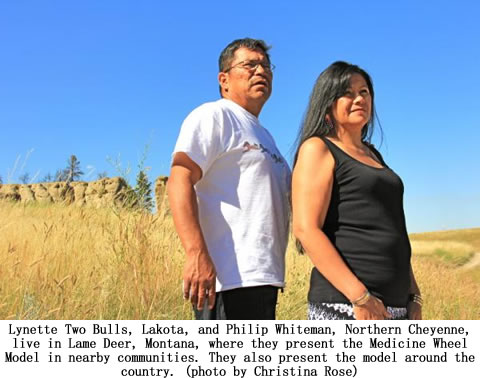 |
Canku Ota
|
 |
|
(Many Paths)
|
||
|
An Online Newsletter
Celebrating Native America
|
||
|
September 2014 - Volume
12 Number 9
|
||
|
|
||
|
Linear Thinking is
For Squares! Circular Thinking and the Medicine Wheel
|
||
|
by Christina Rose -
Indian Country Today Media Network
|
||
|
Most indigenous people would agree, until the mainstream "gets it," change in the world will not occur. These days, Philip Whiteman Jr., Northern Cheyenne, and Lynette Two Bulls, Lakota, are doing their best to help the mainstream "get it." The good news is that they do, and are asking for more.
Taking the concept of the medicine wheel and universal principles of spirit, Whiteman and Two Bulls developed the Medicine Wheel Model and have taken it on the road. Their program has nothing to do with religious practice and everything to do with helping people deal with stress, decisions, and how to identify thought processes that interfere with their lives. Linear thinking versus circular thinking are explored in the program, as is the hierarchy inherent in American business and life. "With linear thinking, we rely on logic, institutions, and others to try to protect ourselves. Circular thinking originates from the earth, the universe, and the Creator; we are all connected and all safe," Two Bulls explained at a recent conference. "The Medicine Wheel Model is about social change; it's about having to look internally before you can work externally. We teach ways in which you can stay connected to your own spirit and community, while maintaining that connection to creator, that guide within you, that healing and wellness. You can reconnect back to it, and the healing comes from that." There are other programs based on the Medicine Wheel, but Whiteman and Two Bulls' program is uniquely designed for all people. Participants learn or relearn that without a spiritual basis, linear thinking interferes with the natural ability to experience life and emotions in a full and complete way. From the youth in the annual Northern Cheyenne Fort Robinson Spiritual Run, to veterans' organizations, schools, women's groups, and more, people of all races are learning how colonization and generational trauma affects thoughts and actions. Misty Thomas, director of Santee Sioux Tribe's Dakota Tiwahe Social Services Program received her training certification in the Medicine Wheel Model two years ago. Working now with a national program for foster care, Thomas said, "We are developing a culturally appropriate method to work with Native families involved in foster care, and incorporating pieces of the Medicine Wheel Model into the program." Thomas's enthusiasm comes from her own participation with the Medicine Wheel Model. "I experienced tremendous personal growth and it changed me forever," she said. An increasing number of businesses and groups are calling upon the Medicine Wheel Model in hopes of change. During a recent presentation in upstate New York, Whiteman addressed the crowd and gently helped attendees see that in order to change, new ideas must be introduced. "Your environment dictates your thoughts, and you can't know what you don't know," he said. Whiteman took participants on a journey into spirit and emotion. He described how everyone in America has experienced generational trauma and has fallen victim to Stockholm Syndrome, a state of mind in which victims embrace a way of life that is hurting them. From one physical exercise to the next, Whiteman and Two Bulls explain that through the teachings of the medicine wheel, everyone can return to circular thinking, to a place of spirit rather than ownership, dominance, eminent domain and dominion. Whiteman told the audience, "Lace your fingers and bring your palms together. See where your thumb is. Now do it again, but reverse the placement of your thumb and fingers." Participants report that it feels awkward, wrong, uncomfortable. "That's what change feels like," he said. On July 22, staff members of Green Peace attended a Medicine Wheel Model training conference, and within only two days, a shift in thinking became evident. Brainstorming took on a more positive direction as Whiteman told them, "You can't expect things to be different if you continue to do things the same way." Green Peace staff member Kim Marks said, "It's good to step back and examine how you are communicating," and that, "It is a different training style than I am used to. It takes a while for the information to click." In another recent two-day presentation, people went from, "Well, that's your way, this is ours," to "We will take some of what you offer and incorporate it," to that moment when they recognized how the dominant culture has squelched their creativity and ability to find peace. By the end of the presentation, participants are yearning to break free, and are ready to take these teachings back into the workforce. |
|
insert map here
|
|
|
||
|
|
||
| Canku Ota is a free Newsletter celebrating Native America, its traditions and accomplishments . We do not provide subscriber or visitor names to anyone. Some articles presented in Canku Ota may contain copyright material. We have received appropriate permissions for republishing any articles. Material appearing here is distributed without profit or monetary gain to those who have expressed an interest. This is in accordance with Title 17 U.S.C. Section 107. | ||
|
Canku Ota is a copyright ©
2000 - 2013 of Vicki Williams Barry and Paul Barry.
|
||
 |
 |
|
|
The "Canku
Ota - A Newsletter Celebrating Native America" web site and
its design is the
|
||
|
Copyright ©
1999 - 2013 of Paul C. Barry.
|
||
|
All Rights Reserved.
|
||
